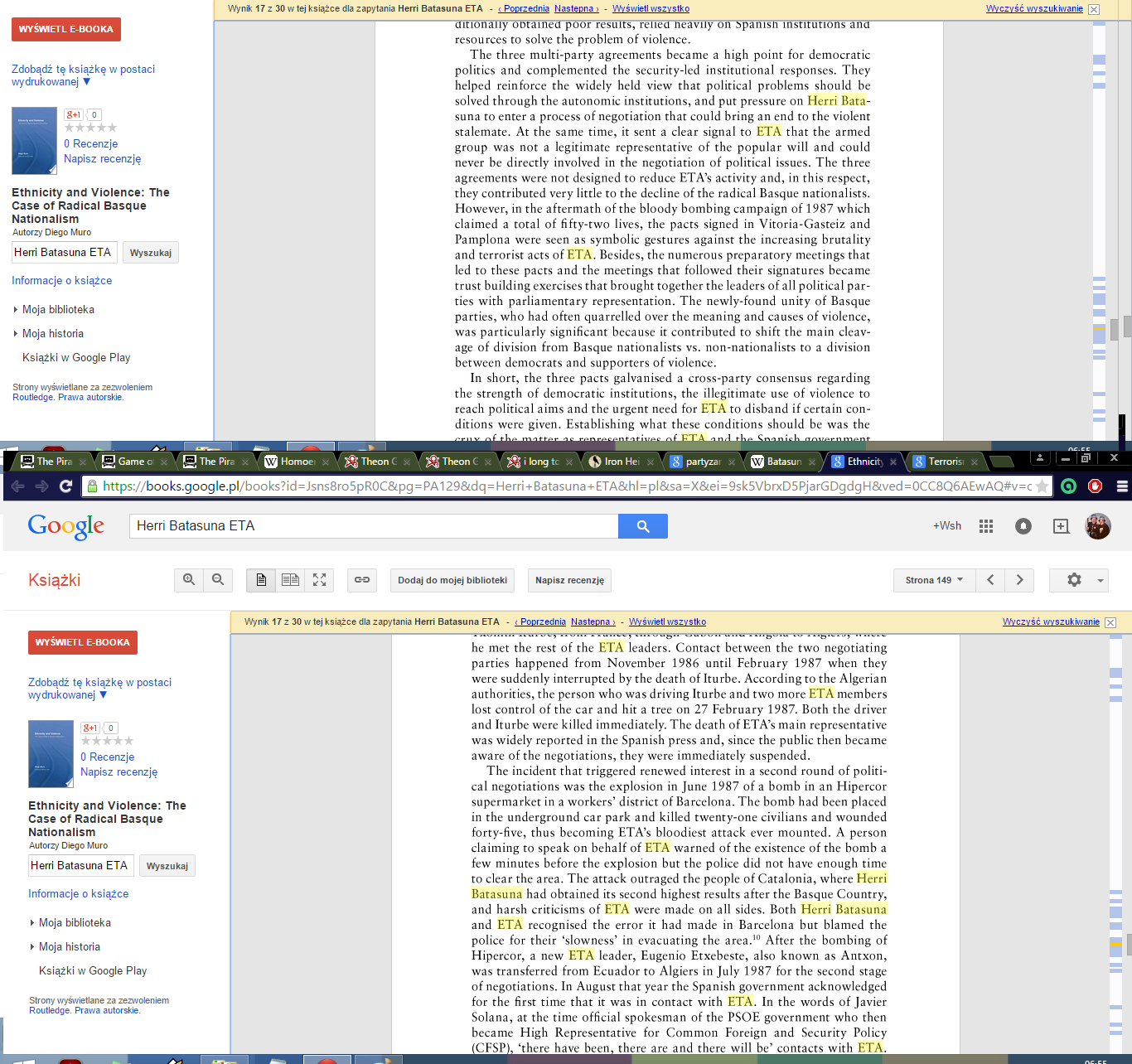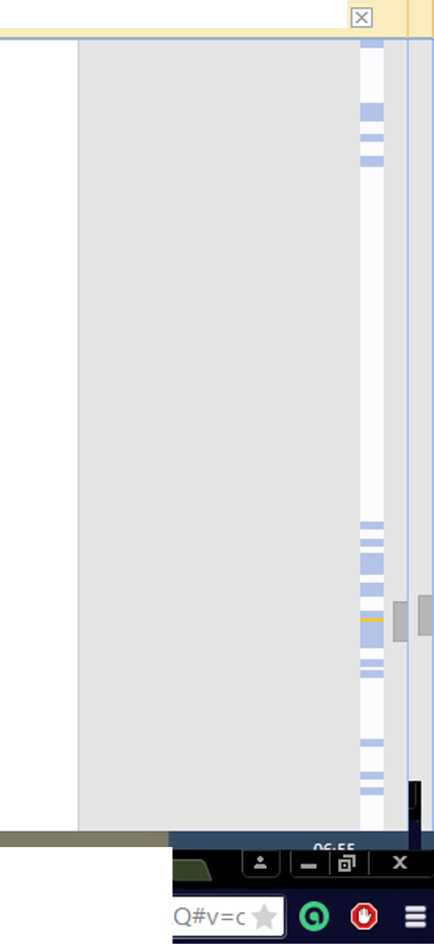bat 6

WYŚWIETL E-BO OKA
Zdobądź tę książkę w postaci wydrukowanej ▼

8+1 ,o|
★ ★★★★
0 Recenzje Napisz recenzję
Wynik 17 z 30 w tej książce dla zapytania Herri Batasuna ETA - < Poprzednia Następna > - Wyświetl wszystko
dihonaily ODtaineci póór resuits, rened heavily on ipantsn irtstitutions ana resources to solve the problem of yiolence.
The three multi-party agreements became a high point for democratic politics and complcmentcd the security-lcd institutional responses. They helped reinforce the widely held view that politieal problems should bc solved through the autonomie institutions, and put pressure on Herri Batasuna to enter a process of negotiation that could bring an end to the violent stalemate. At the same time, it sent a elear signal to ETA that the armed group was not a legitimate representative of the popular will and could never be directly involved in the negotiation of politieal issues. The three agreements were not designed to reduee ETA’s activity and, in this respeet, they contributed very little to the decline of the radical Basque nationalists. However, in the aftermath of the bloody bombing eampaign of 1987 which claimed a total of fifty-two lives, the pacts signed in Vitoria-Gasteiz and Pamplona were seen as symbolie gestures against the inereasing brutality and terrorist aets of F.TA. Bcsidcs, the numerous preparatory meetings that led to these pacts and the meetings that followed their signatures became trust buildingexereises that brought together the leadersof all politieal par-ties with parliamentary representation. The newly-found unity of Basque parties, who had often quarrelled over the meaning and causes of violenee, was particularly significant because it contributed to shift the main cleav-age of division from Basque nationalists vs. non-nationalists to a division between dcmoerats and supporters of violcnce.
In short, the three pacts galvanised a cross-party consensus regarding the strength of democratic institutions, the illegitimate use of violence to reach politieal aims and the urgent need for ETA to disband if certain con-ditions were given. Establishing what these conditions should be was the
^ n i c li i
Ethnicity and Violence: The Case of Radical Basque Nationalism
Autorzy Diego Muro
Herri Batasuna ETA Wyszukaj
Informacje o książce
► Moja biblioteka
► Moja historia Książki w Google Play

W/czyść wyszukiwanie

+Wsh
Strony wyświetlane za zezwoleniem Routledge. Prawa autorskie.
rU
( ETA „.-,,1 rU.
8 Terroris

Herri Batasuna ETA
|
Książki |
I * | Cl 1 |
i ii 55 |
CO |
Dodaj do mojej biblioteki |
Napisz recenzję |
Strona 149 w |
< > |
0 - |
WYŚWIETL E-BO OKA
Zdobądź tę książkę w postaci wydrukowanej ▼
■ g+i o
★ ★★★★
0 Recenzje Napisz recenzję
Ethnicity and Violence: The Case of Radical Basque Nationalism
Autorzy Diego Muro
Herri Batasuna ETA Wyszukaj
Informacje o książce
► Moja biblioteka ► Moja historia Książki w Google Play
Strony wyświetlane za zezwoleniem Routledge. Prawa autorskie.
Wynik 17 z 30 w tej książce dla zapytania Herri Batasuna ETA - < Poprzednia Następna > - Wyświetl wszystko
—|-AJlUUllll UU1ULJ 11U11I i lUHtU) U1IUU{,1I UUUUII U1IU « lllfeUlU W HHWU
he met the rest of the ETA leaders. Contact between the two negotiating parties happened from November 1986 until February 1987 when they were suddenly interrupted by the death of Iturbe. According to the Algerian authorities, the person who was driving Iturbe and two morę ETA members lost control of the car and hit a tree on 27 February 1987. Both the driver and Iturbe were killcd immediately. The death of F.TA’s main represcntative was widely reported in the Spanish press and, sińce the public then became aware of the negotiations, they were immediately suspended.
The incident that triggered renewed interest in a second round of politi-cal negotiations was the explosion in June 1987 of a bomb in an Hipercor supermarket in a workers’ district of Barcelona. The bomb had been placed in the underground car park and killed twenty-one civilians and wounded forty-five, thus becoming ETA’s bloodiest attack ever mounted. A person claiming to speak on behalf of ETA warned of the existence of the bomb a few minutes before the explosion but the police did not have enough time to elear the area. The attack outraged the people of Catalonia, where Herri Batasuna had obtained its sccond highest resuits after the Basque Country, and harsh criticisms of F.TA were madę on all sides. Both Herri Batasuna and ETA recognised the error it had madę in Barcelona but blamed the police for their ‘slowness’ in evacuating the area.1" After the bombing of Hipercor, a new ETA leader, Eugenio Etxebeste, also known as Antxon, was transferred from Ecuador to Algiers in July 1987 for the second stage of negotiations. In August that year the Spanish government acknowledged for the first time that it was in contact with ETA. In the words of Javier Solana, at the time official spokesman of the PSOE govcrnmcnt who then became High Representative for Common Foreign and Security Policy (CFSP), ‘there have been, there are and there will be’ contacts with E TA.
W/czyść wyszukiwanie


AC.CC
Wyszukiwarka
Podobne podstrony:
bat 5 WYŚWIETL E-BO OKA Zdobądź tę książkę w postaci wydrukowanej ▼ ■ g+i o ★ ★★★★ 0 Recenzje
bat 6 WYŚWIETL E-BO OKA Zdobądź tę książkę w postaci wydrukowanej ▼ 8+1 ,o
bat 7 WYŚWIETL E-BO OKA Zdobądź tę książkę w postaci wydrukowanej ▼ 8+1 ,o
bat 7 WYŚWIETL E-BO OKA Zdobądź tę książkę w postaci wydrukowanej ▼ 8+1 ,o
bat 3 -—- WYŚWIETL E-BO OKA Zdobądź tę książkę w postaci wydrukowanej ▼ ■ g+i o★ ★★★★ 0
bat 3 -—- WYŚWIETL E-BO OKA Zdobądź tę książkę w postaci wydrukowanej ▼ ■ g+i o★ ★★★★ 0
bat 1 5.2.2 Heni Batasuna Zdobądź tę książkę w postaci wydrukowanej ▼ 8+1 ,o
ETA nad?sque 1 KUP E-BOOKA-438,90 ZŁ Zdobądź tę książkę w postaci wydrukowanej ▼ 8+1 ,o
ETA nad?sque 2 KUP E-BOOKA-438,90 ZŁ KUP E-BOOKA-438,90 ZŁ Zdobądź tę książkę w postaci wydrukowanej
ETA nad?sque 3 KUP E-BOOKA-438,90 ZŁ KUP E-BOOKA-438,90 ZŁ Zdobądź tę książkę w postaci wydrukowanej
bat 9 WYŚWIETL E-BO OKA Wynik 25 z 30 w tej książce dla zapytania Herri Batasuna ETA - < Poprzedn
Image221 Funkcje te mają postać:DA = ADb = AB+AB = A@BDc = AC+BC+ABĆ = C(A+B) + CAB = CAB+CAB = AB@C
więcej podobnych podstron